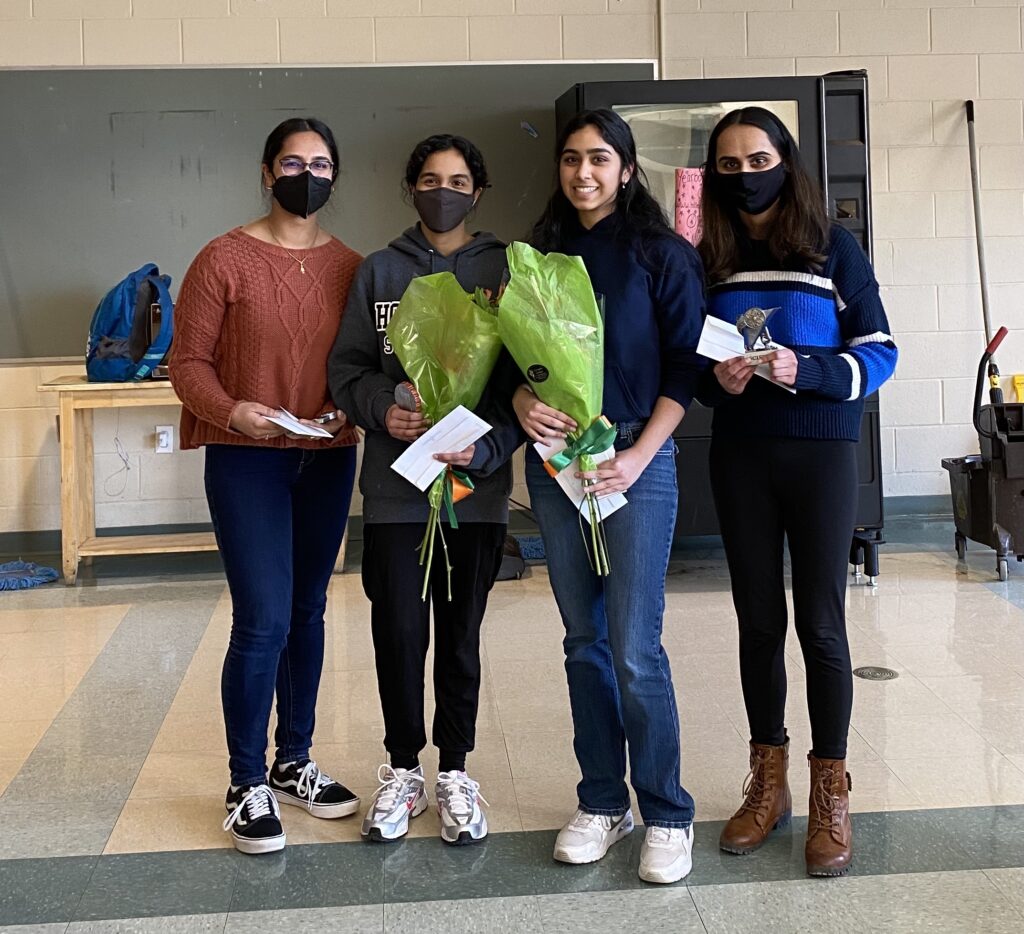
Among the Hopkinton High School students who participated in the Massachusetts Science and Engineering Fair after winning awards at the HHS fair were (from left) Vania Gautam, Ishita Khurana, Sahithi Pogula and Simran Kaur.
Ten Hopkinton High School teams earned prizes at the Massachusetts Science and Engineering Fair, including a group of Grade 9 students who brought home numerous awards.
Additionally, sisters Eva and Esha Bennet qualified to compete at last month’s Regeneron International Science and Engineering Fair held virtually from Atlanta with their project, “Development of An Innovative Alternative Model to Study Intergenerational Transmission of Substance Abuse Potential.”
Hopkinton science fair coordinator Kristen Murphy, who is a chemistry teacher, noted that with the support of administration and the HPTA, almost 50 independent research projects were funded this year in support of more than 90 students.
Murphy explained that this is the 33rd year of the program and about 100 kids in Grades 9-12 work on science projects from September through March. The top 12 finishers at the school fair go on to compete at the regional contest. From there, Hopkinton had 11 teams qualify for the state competition at Massachusetts Institute of Technology, held virtually.
She said that the fun part of the process is when the kids think about their passions and interests and look for problems to solve. They work with a mentor at school on engineering a solution and have numerous opportunities to try and fail as they attempt to fine-tune their projects.
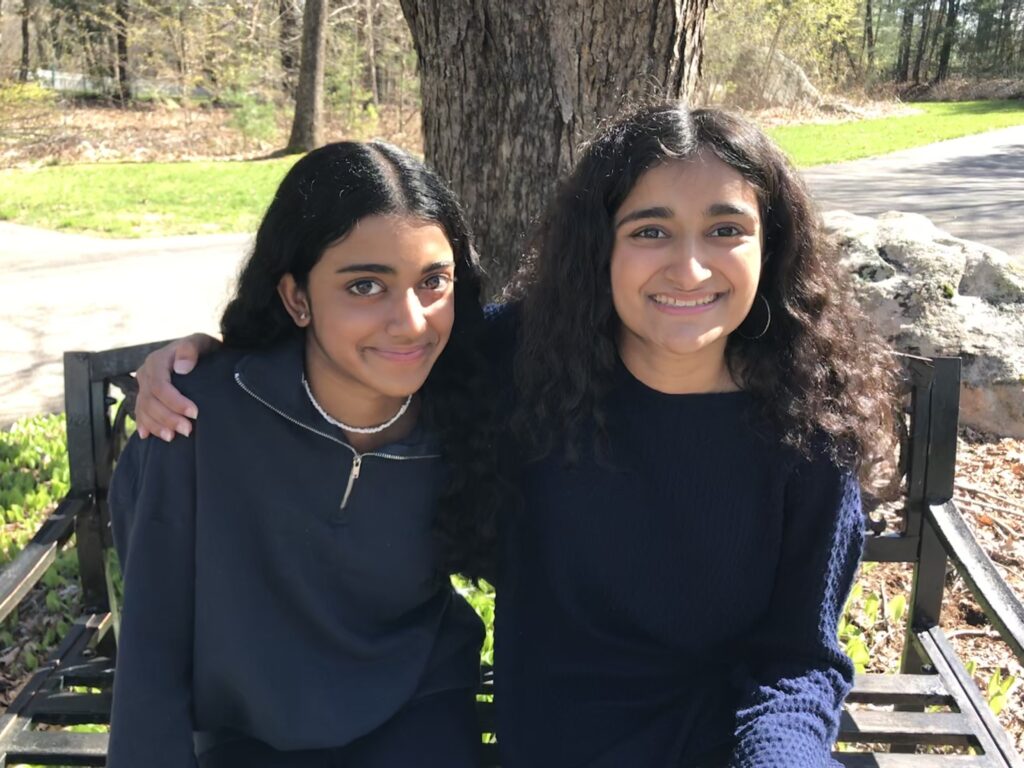
Sisters Esha and Eva Bennet qualified to compete at last month’s International Science and Engineering Fair.
Grade 10 student Evanya Mathur said that she and partner Srilakshmi Venkatesan came up with their project because of similar experiences their families had in rural hospitals in India.
They both have non-verbal family members with whom it is difficult to communicate.
“We wanted to create some sort of alternate iPhone application that would help non-verbal patients use their non-motor skills and abilities to communicate with their loved ones through eye-gazing tracking and machine-learning technology,” Mathur explained.
She said that their project, titled, “PatientConnect: Bridging the Communication Gap for Non-Verbal Patients in Hospital Settings,” was important to them as it was something that could be used within their own families.
Their project placed third at the state fair.
Mathur said she most enjoyed the results of the experience. “You really do not know the feeling of success and achievement unless you have gone through bouts of self-doubt, sleepless nights, nerves and so much more,” she said. “It makes the placement and the award so much more fulfilling and impactful.”
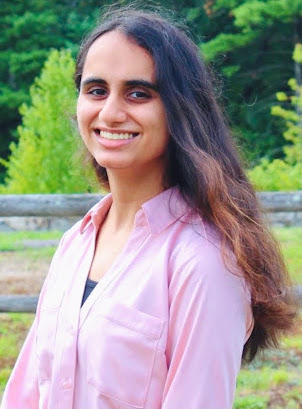
Simran Kaur was one of HHS’ second-place finishers at the state event.
Second-place winner Simran Kaur is a senior who wanted to do a project related to neurodegenerative diseases, particularly Parkinson’s disease.
“To me, neurodegenerative diseases are devastating to patients and families and should be heavily researched in order to find treatments and a potential cure,” Kaur said.
The school fair’s top scorer, Kaur said the most challenging part of the project was coming up with dosages for the animal model she was using, known as brown planaria, which she described as “delicate organisms.”
“It was definitely a hassle trying to find the correct dosage that would not harm but cause a response in the planaria, but it was a worthwhile process in my experimental design,” Kaur said.
“Coming up with control groups, experimental groups and other variables to test is a crucial part of the experimental design, and no two experimental designs are the same,” Kaur said. “Using creativity and innovation to propel an experiment is an enjoyable process of science fair.”
Ninth-grader Kaizar Rangwala and teammates Arin Upalekar and Alex Stephan wanted to come up with “a simple, inexpensive and efficient solution” to combat the problem of microplastic water pollution.
Rangwala explained that they researched water treatments of the past to see if they could be applied.
“We discovered several variants of coagulant chemicals, powder-like compounds that can be mixed with contaminated fluids to make the pollutants easy to remove, and from there, our project bloomed,” Rangwala said.
“A Coherent Solution to Microplastic Pollution” received an honorable mention award at the state fair.
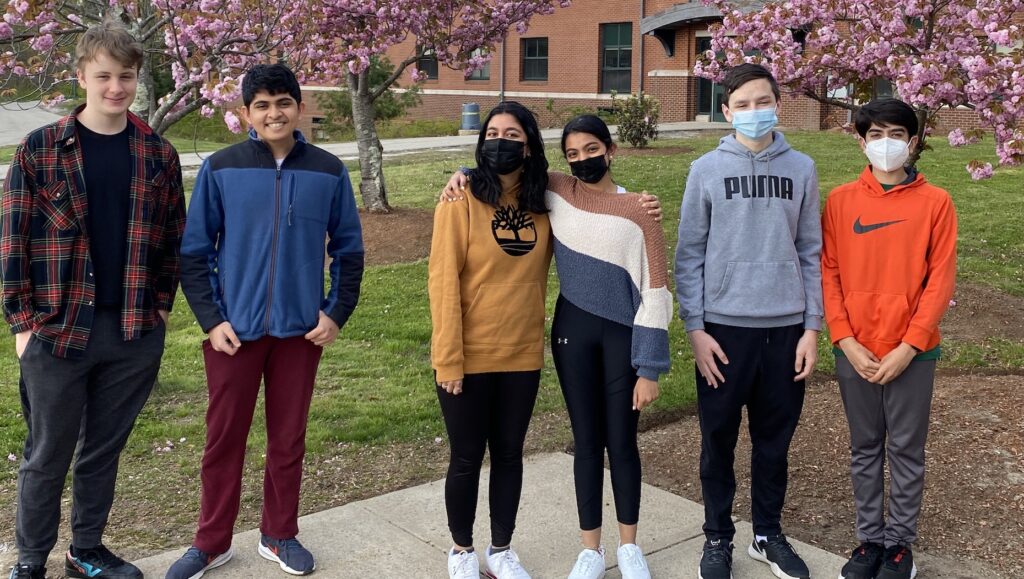
Ninth-graders Alexander Stephens, Arin Upalekar, Garima Chauhan, Shrija Kumar, David Priefer and Dylan Striek pose outside Hopkinton High School.
Rangwala said the most fun part of the experience was “trying to handle all of the weird chemicals we were working with,” adding, “Once, when we were conducting a trial, a chemical disintegrated our plastic equipment. One of them was treating the water really well … until we realized that it turned all the water yellow.”
The team also faced the challenge of considering numerous factors when designing a solution.
“We had to weigh cost-effectiveness, performance and danger to infrastructure and people,” Rangwala said. “No matter how good a chemical is at cleaning water, you don’t want it to melt your house down.”
At the state fair, the students presented to 30 judges comprised of scientists, researchers, engineering and business personnel who asked them questions.
Mathur noted, “Once you see how enthusiastic and truly impressed the judges are, regardless of how many questions they ask or the notes they give you, it feels enriching and unbelievably exciting. Personally, we were lucky that our own judges saw life connections within our project, making it even more fulfilling for us.”
Murphy said it was rewarding to see projects spanning environmental, medical, engineering, technological and computer science realms. She said the projects demonstrate the students’ curiosity about real-world problems.
“They really focused on using their intelligence and passion for science” to develop solutions for issues that matter, Murphy said. “That’s my favorite part of the program.”
Following are the results for HHS students at the Massachusetts State Science and Engineering Fair.
Second place:
B-Vitamin Overconsumption on Diet-Induced Obesity in Danio rerio (Zebrafish), by Ishita Khurana;
Treating 2,4-D-Exposed Planaria with Drug-Supplement Interactions to Palliate Parkinson’s Disease, by Simran Kaur;
Negative Effects of Food Dyes and Sodium Benzoate on Caenorhabditis Elegans, by Shrija Kumar and Garima Chauhan;
Development of An Innovative Alternative Model to Study Intergenerational Transmission of Substance Abuse Potential, by Eva Bennet and Esha Bennet.
Third place:
PatientConnect: Bridging the Communication Gap for Non-Verbal Patients in Hospital Settings, by Evanya Mathur and Srilakshmi Venkatesan;
Effect of Car Exhaust Carbonated Water on Ocimum Basilicum, by Dylan Striek and David Priefer;
Urban Wind Turbines, by Neil Abraham, Brian Gu and Bharat Mekala.
Honorable mention:
A Coherent Solution to Microplastic Pollution, by Arin Upalekar, Kaizar Rangwala and Alex Stephan;
Asynchronous Lidar-enabled 3D modeling for interior navigation, by Saahil Minocha;
In Silico Drug Target Identification via Methylation Factors with Implementation in TP53 Liver Cancer Gene, by Sahithi Pogula.


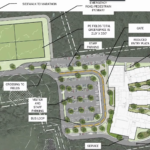
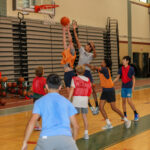

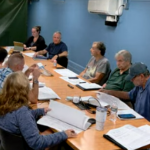
















0 Comments